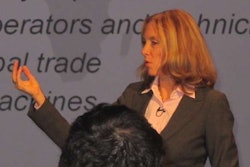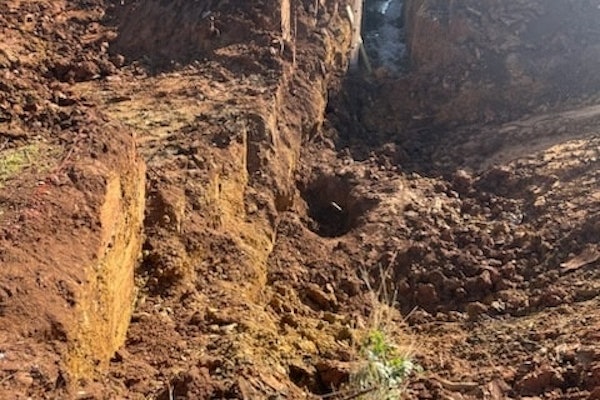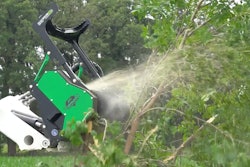Physics and chemistry dictate that most Tier 4 Interim engines follow a common design formula to reduce emissions. Above 75 horsepower most manufacturers have increased fuel injection pressures, boosted turbos, ramped up exhaust gas recirculation (EGR) rates and added aftertreatment that traps or burns off what the Environmental Protection Agency doesn’t want going out the exhaust stack.
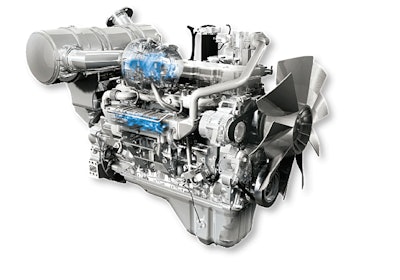 On Komatsu’s Tier 4 Interim engines emissions reductions are handled by a variable geometry turbo, high pressure common rail fuel injection, cooled EGR and a DPF that includes a diesel oxidation catalyst and a catalyzed soot filter.
On Komatsu’s Tier 4 Interim engines emissions reductions are handled by a variable geometry turbo, high pressure common rail fuel injection, cooled EGR and a DPF that includes a diesel oxidation catalyst and a catalyzed soot filter.Komatsu follows this basic formula too, but it has leveraged its expertise in hydraulics to perform some of these functions in a unique way, specifically the control of its variable geometry turbos (VGTs) and EGR valves.
VGT
On a VGT, the vanes of the turbo open and close to increase or decrease the air being fed into the engine. Other ways to do this are to use twin turbos, two-stage turbos, or waste gates that bleed off excess air.
Komatsu has opted for the VGT style turbo above 74 horsepower (see chart on page 42). But unlike most designs in which the vanes are controlled electro-mechanically, Komatsu uses hydraulic pressure. “We feel the hydraulic actuation is more advantageous because the hydraulics provide more power, and it’s more precise,” says Doug Morris, director product marketing, Komatsu America. “It optimizes the airflow of the whole engine.”
 High pressure fuel delivered in a common rail and controlled by the engine’s ECU allows for ultra-precise fuel burn.
High pressure fuel delivered in a common rail and controlled by the engine’s ECU allows for ultra-precise fuel burn.Precise control of the turbo is not only important in maintaining engine power, but in Tier 4 Interim engines this air flow is critical to the effective functioning of the exhaust aftertreatment, Morris says. Komatsu’s VGT adjusts to assist with active regeneration, but it also reduces soot at the point of creation in the cylinder, reducing what passes downstream into the DPF.
EGR
Komatsu increased the amount of exhaust gas recirculating back into the engine, as have most manufacturers transitioning from Tier 3 to Tier 4 Interim. The purpose of pumping exhaust gas back into the cylinders is to dampen combustion temperatures and thus reduce the amount of nitrogen oxides or NOx flowing out the exhaust valves (NOx is one of the emissions the EPA regulates.)
And as with the VGT, Komatsu has plumbed a hydraulic servo into the system to control the EGR valve on its Tier 4 Interim engines above 74 horsepower. “The primary difference with Tier 4 Interim is that the valve position is independent of external working forces,” Morris says. “Before, the valve position was determined by the balance of the spring force and the external force working on the valve. Now it is free from any of the external forces, so you have fine control of the opening and closing of the valve. It’s stronger and more precise.”
Aftertreatment
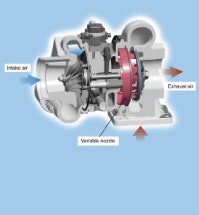 Hydraulic control of the variable nozzle on the turbocharger optimizes air flow to throughout the engine and exhaust aftertreatment.
Hydraulic control of the variable nozzle on the turbocharger optimizes air flow to throughout the engine and exhaust aftertreatment.Downstream of the cylinders, Komatsu uses an aftertreatment setup it calls a Komatsu Diesel Particulate Filter. In this system the exhaust enters a diesel oxidation catalyst (DOC) first. Here the catalytic material converts much of the nitrogen oxide in the exhaust to nitrogen dioxide. “Nitrogen dioxide is a very aggressive oxidizer of soot,” Morris says. “What the machine is doing is using the DOC to clean itself out naturally during normal operation.”
Downstream from the DOC, but still in the same canister, the exhaust enters what the company calls a Komatsu Catalyzed Soot Filter. (A lot of OEMs call this second component a diesel particulate filter or DPF, which is it. But some confusion arises from the fact that others call the whole assembly a DPF. We’ll use the term “soot filter” in this article to avoid confusion.)
In Komatsu’s case, the soot filter’s honeycomb structure traps soot particles, but it also contains catalytic elements to continue the conversion of NO into NO2. Exhaust heat and NO2 will oxidize most of the soot trapped in the filter, a process is referred to as passive regeneration.
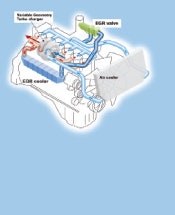 The EGR valve likewise uses hydraulic actuation to maintain the valve position independent of external working forces.
The EGR valve likewise uses hydraulic actuation to maintain the valve position independent of external working forces.Some soot buildup is inevitable. When this happens a sensor measuring exhaust backpressure will signal the engine to inject a “hydrocarbon dose” into the exhaust stream (essentially a shot of diesel fuel) that increases the temperature in the exhaust and oxidizes the latent soot. This is referred to as active regeneration.
On average, Komatsu Tier 4 engines passively regenerate approximately 95 percent of the time using normal exhaust temperatures, Morris says.
Service intervals
Trace amounts of ash build up in the soot filter of every engine that uses this type of aftertreament. This ash cannot be burned out, so the DPF must eventually be removed and cleaned or replaced by a dealer using specialized equipment.
The EPA requires manufacturers to design DPFs to last at least 4,500 hours between ash cleanouts. Morris says Komatsu has more than a million engine hours of field experience with these engines and DPF capacity has not been an issue.
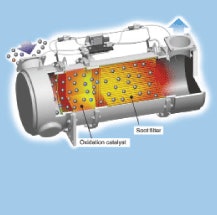 The exhaust aftertreament consists of a diesel oxidation catalyst paired with a catalyzed soot filter, or DPF.
The exhaust aftertreament consists of a diesel oxidation catalyst paired with a catalyzed soot filter, or DPF.Nonetheless Komatsu recognized that contractors and fleet managers might be concerned about the new engines and new maintenance requirements. In response, the company offers its Komatsu Care program for engines 174 horsepower and up and will do the same for smaller engines this year as they acquire the new Tier 4 Interim technology.
With Komatsu Care you get two complementary DPF exchanges within the first five years of the machine’s life, one at 4,500 hours and the next at 9,000 hours. You also get free factory scheduled service and maintenance for the first three years or 2,000 hours, including oil changes and filters and inspections that are performed by factory certified technicians.
Current Tier 4 Interim machine models
Komatsu is currently using these Tier 4 Interim engines in the following machines:
Excavators:
PC210LC-10
PC240LC-10
PC290LC-10
PC360LC-10
PC390LC-10
PC490LC-10
Dozers:
D61-23
D65-17
D155AX-7
Wheel loaders:
WA380-7
WA500-7




